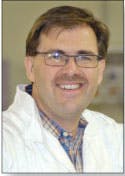“Over the next decade, microbiology labs will see a
significant transformation from discrete manual processes to fully
automated systems, allowing labs to increase throughput, enhance
traceability, reduce costs, and, ultimately, improve patient care. The
evolutionary pattern is already mimicking what has been seen in the
clinical chemistry area over the past 30 years. Large micro labs are
making significant capital investments to build custom systems that
automate their current workflows. These custom systems will eventually
prove to be inflexible, costly to maintain, and expensive to upgrade.
IVD manufacturers will address the market need with task specific
automation products that can easily be integrated with one another via
data concentrators, workflow-management software, and decision-support
systems. Standards will follow which will allow improvements in
interoperability of competing systems. The integration model will
prevail as it provides the best flexibility for labs to upgrade specific
segments of their automation as the technologies evolve. The focus
interest for laboratories will be on the vendors that do not just
automate an existing manual process but, instead, drive automation with
new methods that create added value.”
Doug Flammang, Vice President, Program Management
Microbiology and Lab Automation
bioM'erieux
Maker of VITEK 2, BacT/ALERT, VIDAS,
and other automated in vitro diagnostic testing systems
“Cost saving is the No. 1 issue facing microbiology
laboratories today. Our country's laboratories are under increasing
pressure to save money, resulting in the need for inexpensive, yet
effective, rapid manual microbiology tests. Automated microbiology is
fast, but the costs per test, and initial capital investment is quite
high. Our research and development laboratory is developing fast,
easy-to-use, rapid tests for pathogens such as Candida,
Streptococcus, Nieseria, and MRSA, and has also developed a
line of inexpensive, easy-to-use chromagenic culture media for MRSA,
Candida spp., Staph aureus, Salmonella, and common
urinary-tract pathogens. The No. 2 issue facing the laboratory today is
an aging workforce, with more microbiologists retiring than entering the
field. This has been an emerging problem, but with the efforts of
organizations such as the American Society for Microbiology, we are
doing a good job of attracting young scientists to this important
field.”
Christopher Catani, MT(ASCP), RM(ACM)
Director of Sales, Marketing & Customer Service
Hardy Diagnostics
Maker of HUrBi (Hardy Urine Biplate)
“A key trend in microbiology is in automation of the
pre-analytical phase of the clinical laboratory path of workflow.
Traditionally, automation in specimen setup of microbiology, unlike
chemistry and hematology, has not been fully explored, largely, in part,
because it had been impossible to replicate, with an instrument, the
physical rolling of swabs onto culture plates. Swabs account for a high
percentage of the samples received in a clinical lab, and the challenge
of trying to automate the planting and streaking of swabs had prevented
automation in an area that requires speed and precision. Now, with a
transport system that automatically elutes the specimen into liquid
phase, swabs can be processed as easily as urines. Our invention of a
new swab has opened the door for fully automated systems to process
liquid-based samples in microbiology, because it has transformed one of
the major specimen types received into microbiology to liquid phase. The
specimen process automatically plants and streaks bacteriology
specimens, despite the type or container size. Automation in the
receiving area of microbiology comes at a crucial time when there is a
shortage of qualified staff and an increase in workloads driven by more
surveillance for healthcare-associated infections and emerging
drug-resistance bacteria. This is a viable solution to real challenges
encountered today by the clinical laboratory.”
Norman Sharples
Executive Vice President
Copan Diagnostics Inc.
Maker of Flocked Swabs, ESwab,
and WASP: Walk-Away Specimen Processor
“With microbial resistance to antibiotics on the
rise, laboratories are faced with new challenges. Rapid detection of
resistance is critical to the proper treatment of patients. I think we
will continue seeing medical-device manufacturers developing new and
sophisticated technology for the rapid detection of antibiotic-resistant
bacteria. Consequently, this will place additional emphasis on
quality-control testing. In order to ensure the accuracy of tests being
performed, laboratories must use biological reference materials that are
authentic, traceable and reliable. Even more importantly, they need to
be readily accessible in a convenient format, and acquired and
distributed on a global basis.”
Brad Goskowicz
Chief Marketing Officer
MicroBioLogics Inc.
Maker of KWIK-STIK and LYFO DISK lyophilized microorganism preparations
“Rather than reflect on futuristic musings to discern
trends in microbiology, my task falls in the 'can you teach an old dog
new tricks' category. In this case, the 'old dog' is the ubiquitous
petri plate. It has been around for more than 100 years and still has a
purpose and a use. The 'new trick' is the application of novel
technology to enhance the function of the petri plate to grow
microorganisms; not just any microorganism, but those that will not grow
in air — the anaerobes — independent of special apparatus, such as jars
or chambers. We did this by improving on old technology (the Brewer Lid)
and combining it with new technology (an enzymatic system that
efficiently removes oxygen), Oxyrase. We redesigned and modernized the
dish lid so that it could be mass produced. Then we had to standardize
the enzyme system and formulate a product to perform under conditions
needed to grow anaerobes. The result is a self-contained, anaerobic
chamber that regenerates and maintains the anaerobic environment. The
anaerobic plate separates the dependence of microbial growth from that
of the apparatus needed to create anaerobic conditions — liberating for
microbiologists. The anaerobic plate has a place in labs working with
clinical anaerobes, regardless of the means to grow primary isolates.
The product is suited for subbing, which entails picking and
transferring isolates from the primary plate to a secondary plate to
confirm that its an anaerobe and to purify it for further identification
and for determining antibiotic sensitivity. This anaerobic plate puts
the microbiologist in control of 'working up' the specimen. Each isolate
can be handled independently and worked with optimally, depending on its
rate of growth.”
James C. Copeland, PhD
President
Oxyrase Inc.
Maker of the OxyPlate
“Growing antimicrobial-resistance concerns dictate
the increased need to test isolates against antimicrobics that were
previously assumed effective agents. As international travel and
immigration spreads disease, it is imperative that global surveillance
programs accurately monitor Mycobacterium tuberculosis (MTB) strains
with multiresistant-drug patterns. It is equally important that
laboratories collect accurate epidemiologic data for Gram-negative
bacilli. Over the last several years, it has been increasingly apparent
that many Gram-negative bacilli are also displaying resistance to the
remaining antimicrobics available for treatment. The availability of
reliable automated and manual test methods for MIC determination are
critical to understanding antimicrobial-resistance mechanisms and the
spread of deadly diseases. In addition to utilizing accurate test
methods, surveillance initiatives should also include software
capabilities to appropriately share collected data efficiently.”
Roger Grist
Director, R&D
TREK Diagnostic Systems
Maker of Sensititre AST/ID products and VersaTREK product







